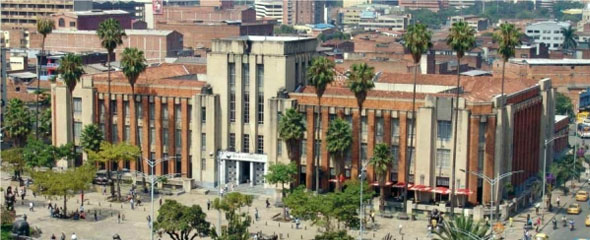
The Museo de Antioquia is where you find the art of Medellín’s pride, Fernando Botero. Ironically though, much of his best art is displayed on Plaza Botero, the square in front of the museum for free. What’s inside is worth the entrance fee, but only just.
The Museo de Antioquia is housed in a large – and though it pre-dates the recent modernist building spree – modernist building that houses far less art than you would expect. Actually, change that to far less art worth your time than you would expect. And its star performer, Colombian Fernando Botero of the blubbery boys and babes, has most of his best stuff out on the patio, available free of charge. But you should still pay the entrance fee. Really.
The bottom floors are really better missed, but if you insist in getting your money’s worth, take a leisurely stroll through the red-walled section, pausing to check out the dimly lit walls of crosses, bibles, studious and bearded portraits of religious men if you like that sort of thing. If you don’t, well keep your pace.
A lime-colored gallery off the main halls offers more men, all straight-backed generals with stiff collars. If you know your history, enjoy. If not, be fascinated that half of them seem to be named Uribe.
Two first floor stops that should be made: a little room made up to be a photo studio, the walls hung with staged but emotive turn-of-the-century photos using the same background that covers the room’s back wall, and “Horizontes”, an intimate portrait of two Colombians looking out over a peaceful landscape, the sky blue and full of possibility.
One floor up, start your circuit at the EPM Gallery, apparently sponsored by the deep pockets of Medellín Public Enterprises, the city’s utility conglomerate. The rooms are a mixture of Warhol-esque company signage and conceptual art—don’t miss the room that is painted to look as if it opens onto other rooms holding as of yet un-hung picture frames. Enough false reality to make you dizzy.
A remake of “Horizontes” is another must, with little changed but for the addition of a low-swooping plane, spewing what can only be assumed to be fumigants. The modern art eventually gives way to war art, of which Colombia inspires plenty. Most striking to this observer was the giant three-panel “Triptico La Agonia.” A preview of the top floor comes with Botero’s fun “Mona Lisa” and one can’t suppress a smile for his neighboring work, “El Obispo Negro.” Award for museum piece most likely to be mistaken for the work of kindergartners goes to “Piezas en forma de Pera.”
Further along, you will turn a corner into a gallery and wonder why they hung a sloppy first draft for a Disney character on the wall. Reading the tag, you’ll learn it is “El despertar del Indio a la civilización” by an artist who was not one of definitely not one of Walt’s workers: Diego Rivera. But the actual best of the gallery is a handful of Medellín-native Débora Arango’s works, which pulse with color and energy, even when they don’t feature sprawling naked women.
Moving on to the Rafael Sáenz Gallery, bring a tissue, because these dark moody works might take you down a notch. The Auditorium Sala holds the museum’s largest mural. All business suits and bare skin, plotting subjugators and writhing oppressed, Pedro Nel Gómez undoubtedly outshines his stairwell efforts here. However, wait for the next floor to take a long look—it’s better viewed from above.
On the top floor, the final stop on this tour, you’ll find the long-awaited Botero galleries. There is also the International Sala, but you should listen to your impatient side and go to Botero first. Rich and incredible scenes greet you in the first two rooms, everything from an adultery amid a family portrait to what appears to be a well-anointed Louis XVI. More oversized celebrities and everyday folk follow.
Treat the next two rooms as calisthenics for the final round, as we see first bull-fighting sketches, then bull-fighting miniatures—though the people remain oversized. Last is the real deal, the bullfight by Botero, where sometimes the bull is bigger than the man and sometimes the man is bigger than the bull, and where both are always larger than life. Tired and done with art, the international sala is just one tactile mess: city scapes that extend right off the wall, big vortexes of tri-colored paintbrushes, and a giant canvas caked with so much paint it seems to have robbed a shoe off its creator. A minimal Rodin will stick out to name hunters.
Exiting into the plaza, a coffee will fortunately only be a step away. Take advantage while admiring, free of charge, Botero’s best.

